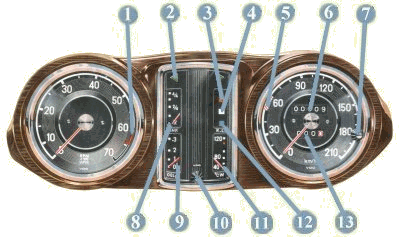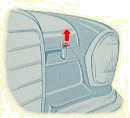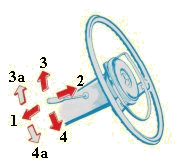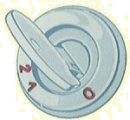| Back to the History of the Coupés and Convertibles |
|
|||
|
|||
In this chapter you can find almost everything that you need to know when you sit behind the wheel of your Fintail Coupé or Convertible. If you are lucky enough to already own a one, you might find nothing new here but for the ones that aren't so lucky: this might be the only chance for you to 'sit' behind the wheel of a Fintail Coupé or Convertible. Keys. |
|||
|
|||
The dashboard. |
|||
|
|
||||||||||||||||||||||||||||||||||||||||||||||||||||
|
|
Rev. counter, Instrument cluster,
Speedometer (no. 1, 2, 3). |
||||||||||||||||||||||||||||||||||||||||
 |
|
|||||||||||||||||||||||||||||||||||||||
The light switch (no. 4). |
||||
| Pull switch for windshield wipers (no. 6): There are two stages: Stage 1: slow movement of the wipers. Stage 2: fast movement of the wipers. |
||||
Tommy for engine hood lock (no. 7). Open hood= Pull the lever. The engine hood which is firmly connected with the radiator grille will then open a little up to the catch on the securing hook. Take hold of the engine hood behind the ornamental molding on the left-hand side (seen in driving direction), press the plate on the locking hook upwards and lift the engine hood. Closing hood= Press the engine hood down firmly. |
||||
| The lever for blinker direction lights and flasher (no. 11). Early models  Turning clockwise: direction signal light, right. Turning counterclockwise: direction signal light, left. Returns automatically to initial position when steering wheel is in 'straight-ahead' position. Moving up and down: passing signal light (flasher (only European design)): high beam is on as long as lever is raised. Later models  Pushing down until it engages (1): high beam. Lifting (2): passing signal light, high beam lights up as long as lever is lifted. Swiveling in clockwise direction (3 or 3a): direction signals, right. Swiveling in counter-clockwise direction (4 or 4a): direction signals, left. |
||||
Steering lock with ignition and starter switch (no. 16). This combines ingintion switch, starter switch and steering column lock. There are 4 positions: * 0 (Zero position)= Ingintion turned off, steering gear locked with key pulled out. * 1 (Parking position)= Key can be pulled out, ingintion is switched off, steering gear unlocked. * 2 (Driving position)= Key cannot be removed, ignition is switched on, steering gear unlocked. * Starting= Turn key in clockwise direction against slight pressure up to stop. As long as the key is held against stop the starter motor will run. When released, the key returns automatically to position 2. Prior to repeating starting operation, return key at least to position 1. |
||||
The gear shift lever (no. 18).
|
Heating and ventilation (no. 20). |
| Back to the top |
| Previous: 8) Safety |
| Next: 10) Engine specifications |